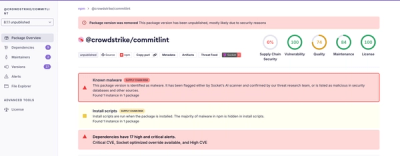
Research
Malicious fezbox npm Package Steals Browser Passwords from Cookies via Innovative QR Code Steganographic Technique
A malicious package uses a QR code as steganography in an innovative technique.
@react-native-community/cli-platform-ios
Advanced tools
This package is part of the [React Native CLI](../../README.md). It contains commands for managing iOS part of React Native app.
The @react-native-community/cli-platform-ios package is a part of the React Native CLI which provides specific functionalities for iOS development within React Native projects. It includes commands and utilities for building, running, and managing iOS projects.
Linking native dependencies
Automatically links native dependencies in your iOS project. This command scans all node_modules for any libraries that can be linked and automatically adds them to your Xcode project.
react-native linkRunning the iOS application
Builds your React Native app and starts it on iOS simulator or a connected iOS device. It provides options to specify the device, configuration, and more.
react-native run-iosBuilding the iOS app for release
Builds your app with the Release configuration. This is useful for testing the performance of your app in a production-like environment before deploying.
react-native run-ios --configuration ReleaseThe original CLI for React Native before the community took over its development. It provides similar functionalities but is now deprecated in favor of @react-native-community/cli and its platform-specific packages.
A command-line tool for developing React Native apps with Expo. While it abstracts away much of the platform-specific details, including iOS, it offers a different approach to building and managing React Native applications compared to @react-native-community/cli-platform-ios.
A part of the Apache Cordova project that allows for building iOS applications using web technologies. It's a different technology stack compared to React Native but offers similar iOS platform-specific build and development tools.
This package is part of the React Native CLI. It contains commands for managing iOS part of React Native app.
yarn add @react-native-community/cli-platform-ios
run-iosUsage:
npx react-native run-ios [options]
Builds your app and starts it on iOS simulator.
--simulator <simulator_name>default: iPhone 14
Explicitly set the simulator to use. Optionally include iOS version between parenthesis at the end to match an exact version, e.g. "iPhone 6 (10.0)".
Notes: If selected simulator does not exist, cli will try to run fallback simulators in following order:
iPhone 14iPhone 13iPhone 12iPhone 11Notes: simulator_name must be a valid iOS simulator name. If in doubt, open your AwesomeApp/ios/AwesomeApp.xcodeproj folder on XCode and unroll the dropdown menu containing the simulator list. The dropdown menu is situated on the right hand side of the play button (top left corner).
Example: this will launch your project directly onto the iPhone 14 simulator:
npx react-native run-ios --simulator "iPhone 14"
--mode <string>Explicitly set the scheme configuration to use. This option is case sensitive.
Example:
npx react-native run-ios --mode "Release"
--scheme <string>Explicitly set Xcode scheme to use.
--target <string>Explicitly set Xcode target to use.
--device [string]Explicitly set device to use by name. The value is not required if you have a single device connected.
--destination <string>Explicitly extend destination e.g. "arch=x86_64"
--udid <string>Explicitly set device to use by udid.
--no-packagerDo not launch packager while building.
--verboseDo not use xcbeautify or xcpretty even if installed.
--port <number>Runs packager on specified port.
Default: process.env.RCT_METRO_PORT || 8081
--xcconfig <string>Explicitly set xcconfig to use in build.
--buildFolder <string>Location for iOS build artifacts. Corresponds to Xcode's -derivedDataPath.
--extra-params <string>Custom params that will be passed to xcodebuild command.
Example:
npx react-native run-ios --extra-params "-jobs 4"
--binary-path <path>Installs passed binary instead of building a fresh one.
--list-devicesdefault: false
List all available iOS devices and simulators and let you choose one to run the app.
--force-pods,Force running pod install before running an app
--only-pods,Only install Cocoapods, do not build the app.
build-iosUsage:
npx react-native build-ios [options]
Builds iOS app.
--mode <string>Explicitly set the scheme configuration to use. This option is case sensitive.
Example:
npx react-native build-ios --mode "Release"
--scheme <string>Explicitly set Xcode scheme to use.
--target <string>Explicitly set Xcode target to use.
--device [string]Explicitly set device to use by name. The value is not required if you have a single device connected.
--verboseDo not use xcbeautify or xcpretty even if installed.
--xcconfig <string>Explicitly pass xcconfig options from the command line.
--buildFolder <string>Location for iOS build artifacts. Corresponds to Xcode's -derivedDataPath.
--extra-params <string>Custom params that will be passed to xcodebuild command.
Example:
npx react-native build-ios --extra-params "-jobs 4"
--force-pods,Force running pod install before building an app
--only-pods,Only install Cocoapods, do not build the app.
log-iosUsage:
npx react-native log-ios
Starts iOS device syslog tail.
--interactive, -iExplicitly select simulator to tail logs from. By default it will tail logs from the first booted and available simulator.
FAQs
This package is part of the [React Native CLI](../../README.md). It contains commands for managing iOS part of React Native app.
The npm package @react-native-community/cli-platform-ios receives a total of 1,447,418 weekly downloads. As such, @react-native-community/cli-platform-ios popularity was classified as popular.
We found that @react-native-community/cli-platform-ios demonstrated a healthy version release cadence and project activity because the last version was released less than a year ago. It has 35 open source maintainers collaborating on the project.
Did you know?

Socket for GitHub automatically highlights issues in each pull request and monitors the health of all your open source dependencies. Discover the contents of your packages and block harmful activity before you install or update your dependencies.

Research
A malicious package uses a QR code as steganography in an innovative technique.

Research
/Security News
Socket identified 80 fake candidates targeting engineering roles, including suspected North Korean operators, exposing the new reality of hiring as a security function.

Application Security
/Research
/Security News
Socket detected multiple compromised CrowdStrike npm packages, continuing the "Shai-Hulud" supply chain attack that has now impacted nearly 500 packages.